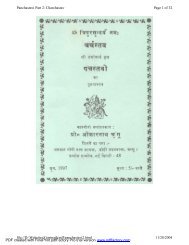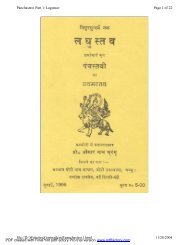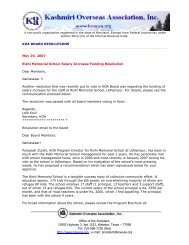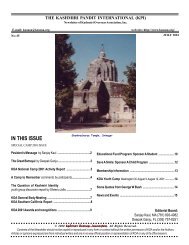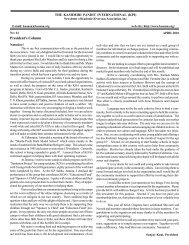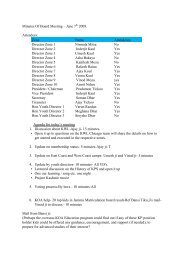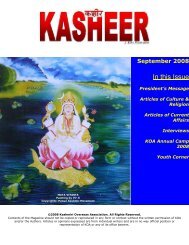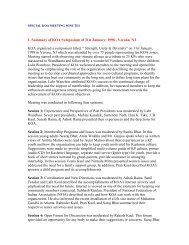Download Essay in PDF format - Kashmiri Overseas Association
Download Essay in PDF format - Kashmiri Overseas Association
Download Essay in PDF format - Kashmiri Overseas Association
You also want an ePaper? Increase the reach of your titles
YUMPU automatically turns print PDFs into web optimized ePapers that Google loves.
The Post-Militancy Political Economy of Jammu and Kashmir*<br />
Akshay Ganju<br />
The many dist<strong>in</strong>ctive features of Jammu and Kashmir, <strong>in</strong>clud<strong>in</strong>g its exceptional political situation,<br />
extreme geography, and cont<strong>in</strong>ual military conflict, have uniquely shaped its population and economy.<br />
Though the <strong>Kashmiri</strong> economy was fairly static for decades after <strong>in</strong>dependence, the recent advent of<br />
militancy has triggered some dramatic trans<strong>format</strong>ions. Despite these new circumstances, however, many<br />
other aspects of the economy rema<strong>in</strong> untouched. An analysis of various sectors of the <strong>Kashmiri</strong> economy<br />
demonstrates the cont<strong>in</strong>uity and change associated with the rise of terrorist activity.<br />
The economy is susta<strong>in</strong>ed by its strengths, such as agriculture, handicrafts, and fruit process<strong>in</strong>g.<br />
Nevertheless, glar<strong>in</strong>g weaknesses – a lack of <strong>in</strong>frastructure, state fiscal problems, the demise of tourism,<br />
unemployment – threaten to spoil the fragile affairs of Jammu and Kashmir. The recent militancy has served<br />
to exacerbate these problems, and careful steps must be taken to address these issues.<br />
There is a great deal of debate over the net effects of terrorist activity <strong>in</strong> the state. There are obvious<br />
negative consequences, such as the loss of tourism and higher state military and security expenditures. These<br />
are quantitatively substantiated by data about tourist arrivals, state budgets, and growth rates. Nevertheless,<br />
other <strong>in</strong>dicators suggest that the <strong>Kashmiri</strong> economy is boom<strong>in</strong>g. An careful analysis of the various sectors of<br />
the economy helps illum<strong>in</strong>ate this seem<strong>in</strong>g contradiction.<br />
Modern Economic Background<br />
Various economic <strong>in</strong>dicators provide different accounts of militancy’s effect on the state. In the<br />
1980s, the growth rate was 8.47%. 1 After the militancy, throughout the 1990s, real growth dropped<br />
significantly – the rest of India boomed, while Kashmir averaged only around 5%. 2 Despite the relatively<br />
*Note: Research for this article was orig<strong>in</strong>ally conducted <strong>in</strong> Jan. 2005, so some data may be out of date.<br />
1<br />
Sreedharan, Ch<strong>in</strong>du. “Blood <strong>in</strong> the Snow: Reviv<strong>in</strong>g the Economy.” Rediff 17 December 1999, Internet Edition:<br />
www.rediff.com/news/1999/dec/17blood.htm.<br />
2<br />
“States and Territories of India: Jammu and Kashmir.” South Asia 2004, Country Surveys. Europa Publications: New York, 2004.<br />
Pg. 247.
sluggish growth rate, the poverty rate <strong>in</strong> Jammu and Kashmir, estimated around 3.48% <strong>in</strong> 2003, 3 is still<br />
among the lowest <strong>in</strong> the nation – poverty for the country as a whole stood at 26.1% <strong>in</strong> 2000. 4<br />
The chang<strong>in</strong>g Per Capita State Domestic Product best reflects militancy’s effect on net state<br />
production. Set aga<strong>in</strong>st an all-India <strong>in</strong>dex, <strong>in</strong>termittent values from 1961 – 1998 are given below. The table,<br />
which <strong>in</strong>cludes the <strong>in</strong>dex value for each time period and the all-India state rank (out of 17) <strong>in</strong> parentheses,<br />
clearly demonstrates the extraord<strong>in</strong>ary growth of the <strong>Kashmiri</strong> economy <strong>in</strong> the 1970s and 1980s. Between<br />
1970 and 1982, Jammu and Kashmir raised five places and crossed the national average. Despite this strong<br />
growth, after the advent of militancy, the state promptly lost all that it had ga<strong>in</strong>ed. As the rest of India<br />
benefited from the liberal reforms of 1991, Jammu and Kashmir was left beh<strong>in</strong>d. Despite these numbers,<br />
there has been a silent growth movement <strong>in</strong> the Valley, as demonstrated by the rise of the Jammu and<br />
Kashmir State Bank. Deposits have grown tremendously s<strong>in</strong>ce militancy began, from $458 million <strong>in</strong> 1989 to<br />
$2.29 billion <strong>in</strong> 2004. An analysis of the four ma<strong>in</strong> sectors of the economy – government spend<strong>in</strong>g and<br />
enterprises, agriculture, tourism, and <strong>in</strong>dustry – helps expla<strong>in</strong> these apparent contradictions.<br />
Index of Per Capita State Domestic Product at Constant Prices (All India =<br />
100): Selected Years<br />
Government Spend<strong>in</strong>g, Infrastructure, and Enterprises<br />
5<br />
Year 1961 - 62 1970 – 71 1981 – 82 1990 - 91 1997 – 98<br />
J&K Index Value (Rank) 83 (12) 86 (13) 106 (7) 79 (11) 72 (13)<br />
The fiscal deal<strong>in</strong>gs of the Jammu and Kashmir state government are <strong>in</strong>strumental <strong>in</strong> the work<strong>in</strong>gs of<br />
the whole economy. The total bureaucracy of the Kashmir Valley alone is estimated to be around 350,000<br />
people, or one <strong>in</strong> seventeen residents. The government payroll accounts for two-thirds of the state’s total<br />
budget of $1.2 billion. 6 The budget itself is spiral<strong>in</strong>g out of control. The revenue deficit <strong>in</strong>creased 77% from<br />
2000 – 01, to Rs 9.6 billion – <strong>in</strong> 1990, the deficit stood at only Rs 574 million. 7,8 Several theories expla<strong>in</strong> this<br />
3<br />
Government of India. Plann<strong>in</strong>g Commission. State Development Report, Jammu and Kashmir. New Delhi: 2003.<br />
plann<strong>in</strong>gcommission.nic.<strong>in</strong>/plans/stateplan/sdr_jandk/sdr_jandk.htm.<br />
4<br />
Chopra, Geetanjali, and Manasseh, Kar<strong>in</strong>a. “India Country Brief.” The World Bank <strong>in</strong> India: September 2004.<br />
www.worldbank.org.<strong>in</strong>.<br />
5<br />
Krishna, K.L. “Work<strong>in</strong>g Paper No. 144 – Patterns and Determ<strong>in</strong>ants of Economic Growth <strong>in</strong> Indian States.” Indian Counsel for<br />
Research on International Economic Relations. New Delhi: September 2004. www.icrier.res.<strong>in</strong>.<br />
6<br />
Waldman, Amy. “Border Tension a Growth Industry for Kashmir.” The New York Times 18 October 2002: A3. Lexis-Nexis.<br />
Harvard College Library. 20 December 2004: www.lexis-nexis.com.<br />
7<br />
Sreedharan, Ch<strong>in</strong>du.
dismal record. Large amounts of state funds are allegedly lost through rampant corruption amongst<br />
government officials, though prosecution is rare. 9 Beyond that, however, there are many controversies<br />
surround<strong>in</strong>g the allocation and use of federal funds by the state government.<br />
In 2001, Jammu and Kashmir received $1.27 billion from the Government of India – the fourth<br />
highest per capita federal economic assistance <strong>in</strong> the country. 10 The Kashmir Valley alone, home to slightly<br />
more than half the population, got $812 million. 11 Furthermore, as Jammu and Kashmir is classified as a<br />
Special Category State, it receives 90% of its funds <strong>in</strong> grants, and only 10% <strong>in</strong> loans. Most states <strong>in</strong> India<br />
receive 70% of their aid <strong>in</strong> loans, and only 30% <strong>in</strong> grants. 12 Despite this federal generosity, the state<br />
government still blames its fiscal woes on New Delhi’s st<strong>in</strong>g<strong>in</strong>ess. The federal aid structure accorded to<br />
Jammu and Kashmir as a Special Category State started <strong>in</strong> 1991. The state government, however, believes<br />
that the fund<strong>in</strong>g should be retroactive to when the state was first awarded this status <strong>in</strong> 1966, and therefore<br />
much of its current debt to New Delhi should be waived. 13 The Sr<strong>in</strong>agar government also compla<strong>in</strong>s that its<br />
security expenditure due to cross-border terrorism has not been adequately reimbursed. State security<br />
spend<strong>in</strong>g <strong>in</strong>creased from nearly noth<strong>in</strong>g <strong>in</strong> 1989 to Rs 3.05 billion by 1999. At that time the state alleged that<br />
the federal government owed Rs 8.96 billion <strong>in</strong> security expenditures. 14 Accord<strong>in</strong>g to the state government,<br />
these unpaid debts and the misstructure of federal aid are responsible for the deepen<strong>in</strong>g fiscal crisis.<br />
Another possible explanation for the messy budget <strong>in</strong>volves the state’s power crisis. One estimate<br />
claims that 20% - 25% of central government funds sent to Kashmir are used to pay for power, 15 as it imports<br />
over 15 billion megawatts a year; 16 <strong>in</strong> 1999 the state government owed Rs 600 million to the National<br />
Electricity Grid. 17 Despite this dismal power situation, Jammu and Kashmir has immense hydroelectric<br />
8<br />
Government of India 353.<br />
9<br />
Waldman, Amy.<br />
10<br />
Dewan, Parvez. Jammu, Kashmir, Ladakh. New Delhi: Manas Publications, 2002. www.mshel.com/book00044.html.<br />
11<br />
Waldman, Amy.<br />
12<br />
Government of India 364.<br />
13<br />
Bhosle, Varsha. “Rais<strong>in</strong>g Ca<strong>in</strong> – The Rediff Interview: Dr. Farooq Abdullah.” Rediff 1 September 1999, Internet Edition:<br />
www.rediff.com/news/1999/sep/01farooq.htm.<br />
14<br />
Sreedharan, Ch<strong>in</strong>du.<br />
15<br />
Dewan, Parvez.<br />
16<br />
Khan, M. Y. “Summary of Talk by M.Y. Khan, Chairman and CEO of the Jammu and Kashmir Bank Ltd.” South Asia Program<br />
– Center for Strategic and International Studies: Wash<strong>in</strong>gton, 28 May 2004. www.csis.org/saprog.<br />
17<br />
Bhosle, Varsha.
potential due to its rugged terra<strong>in</strong> and profuse water sources – upwards of 20,000 megawatts a year. 18<br />
Nevertheless, total <strong>in</strong>stalled capacity <strong>in</strong> 2000 – 01 was only 537.76 megawatts. 19 With proper <strong>in</strong>frastructure<br />
and development, the state would be able to end its power crisis and even sell excess power to other states.<br />
The <strong>in</strong>flux of terrorist activities has left the state <strong>in</strong>frastructure <strong>in</strong> shambles, with the destruction of<br />
758 schools, n<strong>in</strong>e hospitals, 243 bridges, 1,264 other government build<strong>in</strong>gs, 9,309 homes, and 1,659 shops<br />
between 1988 and 1997. 20 Though much of this damage has been repaired, some restorations have been<br />
neglected due to the state budget crisis. For example, <strong>in</strong> 1996, 157 major and 244 m<strong>in</strong>or bridges were<br />
recognized as need<strong>in</strong>g repair. Only 109 major bridges and 128 m<strong>in</strong>or bridges were actually reconstructed. 21<br />
Kashmir’s <strong>in</strong>frastructure woes cannot all be blamed on terrorism and the state government. Many<br />
problems have existed for decades, and are due to historical issues with limited development, little <strong>in</strong>dustry,<br />
rough landscape, and rural population. For example, Jammu and Kashmir has very low road and rail density,<br />
especially compared to other states with similar terra<strong>in</strong>. The state has only 127 kilometers of road per 1000<br />
square kilometers of land area. That compares poorly to Assam (872/1000 sq. km.) and nearby Himachal<br />
Pradesh (542/1000 sq. km.). Its rail density is also the lowest, at .40/1000 sq. km. 22 The rail term<strong>in</strong>us of the<br />
state lies at Jammu, <strong>in</strong> the far south, and there is only one road connection to Sr<strong>in</strong>agar and Leh. This road,<br />
National Highway 1, is extremely perilous and is closed for much of the year. There are regional airports at<br />
Jammu, Sr<strong>in</strong>agar, and Leh. The lack of a railroad and cheap, efficient modes of transportation <strong>in</strong> the state<br />
have proved extremely detrimental to <strong>in</strong>dustrial growth and development. The state government considers a<br />
rail route to the Kashmir Valley <strong>in</strong>tegral to <strong>in</strong>dustrial development, and condemns the federal government for<br />
the delay <strong>in</strong> completion of the project. 23 Work is currently underway on several different sections of the<br />
proposed 287-kilometer, Rs 3.6 billion Udhampur – Sr<strong>in</strong>agar – Baramulla railway l<strong>in</strong>e. The entire project<br />
should be f<strong>in</strong>ished with<strong>in</strong> five years.<br />
18 Government of India 75.<br />
19 Government of India 45.<br />
20 Dewan, Parvez.<br />
21 Government of India 130.<br />
22 Government of India 45.<br />
23 Bhosle, Varsha.
Militancy itself has raised some <strong>in</strong>frastructural concerns very specific to Jammu and Kashmir. For<br />
example, the development of telecommunications has been h<strong>in</strong>dered due to security considerations - even<br />
cellular phone networks were not allowed <strong>in</strong> the state until late 2003. 24 Another specific state concern is the<br />
healthcare <strong>in</strong>dustry. An <strong>in</strong>terest<strong>in</strong>g case study with<strong>in</strong> this segment is the condition of the psychiatric facilities<br />
with<strong>in</strong> Jammu and Kashmir. The terrorist movement, and the associated death and upheaval, has led to<br />
widespread psychological troubles. There is trauma associated with military service, migrat<strong>in</strong>g families, and<br />
<strong>in</strong>dividuals cop<strong>in</strong>g with loss. The ma<strong>in</strong> psychiatric facility <strong>in</strong> Sr<strong>in</strong>agar saw its caseload grow from 3,000 <strong>in</strong><br />
1989 to 18,000 <strong>in</strong> 1990. 25 In 2001 it saw up to 250 people daily, a patient total six times greater than <strong>in</strong> the<br />
pre-militancy era. 26,27 The situation is not improv<strong>in</strong>g, either. In 2002 the Sr<strong>in</strong>agar facility dealt with 48,000<br />
patients. By 2003 that number had grown to 63,000. 28 Hospitals <strong>in</strong> both Jammu and Sr<strong>in</strong>agar must cope with<br />
overcrowd<strong>in</strong>g due to <strong>in</strong>sufficient funds and resources. Recently, Medic<strong>in</strong>s Sans Frontiers (MSF) has started<br />
work<strong>in</strong>g <strong>in</strong> the Kashmir Valley; the organization provides outpatient resources to psychiatric patients and<br />
runs public awareness campaigns and community <strong>in</strong>itiatives. 29 Despite this help, the state healthcare system<br />
is still overwhelmed and <strong>in</strong> dire need of resources, space, and staff.<br />
The state government also wrestles with the massive problem of unemployment. Over 100,000 youth<br />
are currently unemployed, 30 and the problem is worsen<strong>in</strong>g – the total number of unemployed <strong>in</strong> 2000 was<br />
almost 50% higher than <strong>in</strong> 1990. 31 There are several contribut<strong>in</strong>g factors to this trend. Jammu and Kashmir<br />
has experienced a recent pattern of high population growth: 28.91% from 1981 to 1991, and 30.46% from<br />
1991 to 2001. As a comparison, the population of the whole country grew 23.56% from 1981 to 1991, and<br />
24<br />
“States and Territories of India: Jammu and Kashmir” 247.<br />
25<br />
Habibullah, Wajahat. “The Political Economy of the Kashmir Conflict – Opportunities for Economic Peacebuild<strong>in</strong>g and for U.S.<br />
Policy.” United States Institute of Peace. Wash<strong>in</strong>gton: June 2004. www.usip.org/pubs/specialreports/sr121.html.<br />
26<br />
“Mental Health Deteriorat<strong>in</strong>g <strong>in</strong> J&K: Study.” The Deccan Herald 2 April 2004, Internet Edition:<br />
www.deccanherald.com/deccanherald/apr022004/n3.asp.<br />
27<br />
Husse<strong>in</strong>, Masood. “J&K Takes a Hit on the M<strong>in</strong>dfield.” The Economic Times 1 April 2004, Internet Edition:<br />
economictimes.<strong>in</strong>diatimes.com/articleshow/595484.cms.<br />
28<br />
Ramesh, Randeep. “Heal<strong>in</strong>g the Hidden Casualties of Kashmir.” The Guardian 8 January 2004, Internet Edition:<br />
society.guardian.co.uk/christmasappeal/story/0,11321,1118304,00.html.<br />
29<br />
“India: Fight<strong>in</strong>g TB and a Cycle of Violence.” Medic<strong>in</strong>s Sans Frontiers. India: 23 June 2004.<br />
www.msf.org/countries/page.cfm?articleid=7A061E37-0AAD-4F4D-9062802B742A19BB.<br />
30<br />
Khan, M. Y.<br />
31<br />
Government of India 112.
21.43% from 1991 to 2001. 32 Not only are the correspond<strong>in</strong>g rates higher for Jammu and Kashmir, but while<br />
the decadal rate of growth <strong>in</strong>creased <strong>in</strong> Jammu and Kashmir, it decreased for the rest of the country. These<br />
high growth rates are accompanied by a similar growth <strong>in</strong> the workforce – dur<strong>in</strong>g the same time period the<br />
total number of workers <strong>in</strong> the state rose by 39%. 33 These workers have not been absorbed by the agriculture-<br />
and handicraft-dom<strong>in</strong>ated economy of the state; they are left to jo<strong>in</strong> the ranks of the jobless. Furthermore, the<br />
numbers of educated unemployed is grow<strong>in</strong>g, a result of the free higher education provided to residents of<br />
the state and the lack of <strong>in</strong>dustry. 34 The government, which used to employ such workers, has cut back on<br />
new additions due to the current budget problems. This has led to a deepen<strong>in</strong>g employment crisis. The<br />
situation is dangerous as well – many unemployed young men are drawn to terrorist groups, who offer the<br />
best opportunity to make money. 35<br />
The state government must deal with its fiscal issues before it can help the rest of the economy. Fiscal<br />
deficits must be reduced, aid from the central government must be effectively utilized, and state enterprises,<br />
such as those <strong>in</strong> the power sector, must be reformed. Only then can other press<strong>in</strong>g issues, such as healthcare<br />
and unemployment, be addressed.<br />
Agriculture<br />
With the downfall of tourism and the lack of organized <strong>in</strong>dustry, agriculture has been the backbone of<br />
the state economy. Agriculture and related activities employ around 80% of the population and account for<br />
60% of the state <strong>in</strong>come. 36,37 Four-fifths of the state’s population resides <strong>in</strong> rural areas, a much larger<br />
proportion than the rest of the country. 38 This sector of the economy, which carries the state, has been barely<br />
affected by the rise of militancy <strong>in</strong> the 1990s. The total area under cultivation has almost rema<strong>in</strong>ed the same,<br />
32 Government of India 117.<br />
33 Government of India 110.<br />
34 Government of India 120.<br />
35 Hababullah, Wajahat.<br />
36 Government of India 43.<br />
37 “States and Territories of India: Jammu and Kashmir” 247.<br />
38 “Jammu & Kashmir: A Profile.” The Official Website of Jammu and Kashmir Government, India. 16 December 2004. Jammu<br />
and Kashmir Government, India. 20 December 2004 jammukashmir.nic.<strong>in</strong>/profile/facts.htm.
is<strong>in</strong>g from 731,000 hectares <strong>in</strong> 1990 to 733,000 hectares <strong>in</strong> 2000. 39 Rice, wheat, and maize are the ma<strong>in</strong><br />
crops, though Jammu and Kashmir is also the largest producer of saffron <strong>in</strong> the subcont<strong>in</strong>ent. 40<br />
Despite the good performance of the agriculture <strong>in</strong> Jammu and Kashmir, it rema<strong>in</strong>s mostly a<br />
subsistence sector. 41 There are few process<strong>in</strong>g facilities, few agriculture-related <strong>in</strong>dustries, and therefore few<br />
opportunities for growth. This massive segment of the economy, conta<strong>in</strong><strong>in</strong>g more than three-quarters of the<br />
total population, has limited potential and currently cannot absorb new, educated workers. As such, it<br />
cont<strong>in</strong>ues to imprison the <strong>Kashmiri</strong> people <strong>in</strong> a primitive lifestyle, with few prospects.<br />
The lack of facilities and the agriculture dom<strong>in</strong>ation also forces an unhealthy dependence upon the<br />
general Indian market. With no cann<strong>in</strong>g, bottl<strong>in</strong>g, or storage facilities, Jammu and Kashmir must<br />
immediately sell its goods elsewhere <strong>in</strong> India. 42 This lack of facilities limits <strong>in</strong>ternational export, and<br />
eventually results <strong>in</strong> losses by <strong>Kashmiri</strong> farmers on the open market, especially when forced to compete<br />
aga<strong>in</strong>st higher perform<strong>in</strong>g states such as Punjab.<br />
Agriculture has rema<strong>in</strong>ed the backbone of the <strong>Kashmiri</strong> economy. Nevertheless, much more can be<br />
done to boost production and <strong>in</strong>dustry with<strong>in</strong> the sector, to <strong>in</strong>crease employment and to turn Jammu and<br />
Kashmir <strong>in</strong>to an effective competitor <strong>in</strong> the Indian market. This sector of the economy is currently mired <strong>in</strong><br />
traditionalism, with old practices, old tools, and old levels of production.<br />
Tourism<br />
The biggest casualty of the militant activity has been the tourist <strong>in</strong>dustry <strong>in</strong> Jammu and Kashmir.<br />
More than 700,000 tourists flocked to the Kashmir Valley every year, drawn to the “Switzerland of the East”<br />
with promises of “Paradise on Earth.” 43 S<strong>in</strong>ce the start of terrorist activity <strong>in</strong> 1989, however, tourism to the<br />
Valley dropped sharply, from 722,035 <strong>in</strong> 1988 to a low of 6,267 <strong>in</strong> 1991. As illustrated <strong>in</strong> the follow<strong>in</strong>g<br />
table, tourism <strong>in</strong> Kashmir rema<strong>in</strong>ed negligible throughout the 1990s, with a slight spike <strong>in</strong> 1999. The Kargil<br />
39 Government of India 46.<br />
40 “States and Territories of India: Jammu and Kashmir” 247.<br />
41 Government of India 118.<br />
42 Ahmad, Mukthar. “’Kashmir Can Become Prosperous <strong>in</strong> a Short Time.’” Rediff 17 December 1999, Internet Edition:<br />
www.rediff.com/news/1999/dec/17blood1.htm.<br />
43 “Jammu and Kashmir.” Community In<strong>format</strong>ion Centers. 12 March 2003. Department of In<strong>format</strong>ion Technology, Government<br />
of India. 4 January 2005 www.cic.nic.<strong>in</strong>/jammu1.htm.
Year<br />
Tourist Arrival <strong>in</strong> Jammu and Kashmir 1988-2002 44<br />
Note: D – Domestic; F – Foreign; T – Total; O.St – Outside State<br />
* Tourist arrival figures for the year 2002 are up to May for Kashmir Valley, up to April for Ladakh and Vaishno Devi.<br />
War between India and Pakistan <strong>in</strong> July of that year quickly put an end to the growth, and the numbers were<br />
down aga<strong>in</strong> <strong>in</strong> 2001.<br />
44 Government of India 45.<br />
Kashmir Valley Ladakh Vaishnodevi<br />
D F T D F T<br />
Amarnath<br />
State O. St. T<br />
1988 662097 59938 722035 8608 16256 24864 96055 259891 1732764 1992595<br />
1989 490212 67762 557977 6689 16079 22748 95238 262691 2049310 2312001<br />
1990 6095 4627 10722 396 8342 6738 4824 395202 1774000 2169202<br />
1991 1400 4887 6267 1041 8014 9055 15599 439722 2711588 3151310<br />
1992 1175 9149 10324 2438 13580 16018 54638 445580 3081709 3527289<br />
1993 - 8026 8026 2000 12401 14401 56000 461443 2907302 3368735<br />
1994 500 9314 9814 2080 15369 17449 37000 471101 3234844 3705945<br />
1995 322 8198 8520 5594 12391 17985 60000 549778 3482349 4032127<br />
1996 375 9592 9967 3537 13036 16573 120000 582213 3753319 4335532<br />
1997 7027 9111 16131 3991 12810 16801 79035 495165 3939085 4434233<br />
1998 99636 10247 109883 6792 15238 22030 149920 540453 4081639 4622097<br />
1999 200162 17130 217292 1905 96669 11574 114366 635042 4033298 4668340<br />
2000 104337 7575 111912 6217 11825 18042 173334 - - 5109575<br />
2001 66732 5859 72591 4260 15439 19699 119037 - - 5056919<br />
2002* 7993 1015 9008 87 361 448 N.A - - 1053771
While Ladakhi and <strong>Kashmiri</strong> tourism have decl<strong>in</strong>ed, Jammu tourism is actually on the rise. Though<br />
not considered as beautiful as Kashmir, the “City of Temples” 45 is the start<strong>in</strong>g po<strong>in</strong>t for the pilgrimage to<br />
Vaishnodevi, a holy site <strong>in</strong> the mounta<strong>in</strong>s to the northwest. Massive structural improvements and<br />
development have led to skyrocket<strong>in</strong>g numbers of pilgrims, as evidenced by the table. Amarnath, another<br />
holy site located <strong>in</strong> the mounta<strong>in</strong>s west of Sr<strong>in</strong>agar, has also surpassed its pre-militancy numbers.<br />
There is no exact figure on the importance of pre-militancy tourism to the Valley. Nevertheless, it is<br />
estimated that by the late 1980s, it accounted for around 16% of the state’s domestic product, 46,47 and tourism<br />
and related activities employed around 30% of the population. 48 It was the second only to agriculture, 49 and<br />
the loss of tourist traffic to Kashmir deeply wounded the economy.<br />
Nevertheless, new unconventional forms of tourism have ameliorated some of the damage. An<br />
<strong>in</strong>dustry of “olive tourism” grew around the 350,000 Indian Army troops stationed <strong>in</strong> the state. These new<br />
tourists, the troops and their families, spend a great deal of cash <strong>in</strong> the Valley: they buy groceries, jewelry,<br />
and local crafts. 50 The military itself purchases local supplies as well – olive cloth fills tailor shops and olive-<br />
clad soldiers fill hotels year-round, whereas tourist traffic was only seasonal. 51 There is even a militant<br />
tourist <strong>in</strong>dustry, as they pay villagers cash <strong>in</strong> exchange for food, shelter, or <strong>in</strong><strong>format</strong>ion about troops. 52 Both<br />
groups have contributed to the afore-mentioned rise of the Jammu and Kashmir State Bank, as troops deposit<br />
paychecks and militants use the bank to funnel money from <strong>in</strong>ternational f<strong>in</strong>anciers.<br />
Tourism as an <strong>in</strong>dustry has been hardest hit by the unrest <strong>in</strong> Kashmir. Though raw numbers have<br />
gone down, conventional travelers have been somewhat replaced with a new conception of tourism; army<br />
personnel and their families, as well as militants themselves, have flooded the Valley with fresh cash and<br />
45<br />
“Jammu and Kashmir.”<br />
46<br />
Sreedharan, Ch<strong>in</strong>du.<br />
47<br />
Government of India 250.<br />
48<br />
Ibid.<br />
49<br />
Dewan, Parvez.<br />
50<br />
Baldauf Scott. “In Kashmir, War is Also Bus<strong>in</strong>ess.” Christian Science Monitor 13 July 2001, Internet Edition:<br />
csmonitor.com/cgi-b<strong>in</strong>/durableRedirect.pl?/durable/2001/07/13/p1s3.htm.<br />
51<br />
Sreedharan, Ch<strong>in</strong>du.<br />
52<br />
Baldauf, Scott.
demands for new services. Increased traffic to Jammu and Ladakh has also proved to be an effective partial<br />
substitute for the losses <strong>in</strong> Kashmir.<br />
Industry<br />
Kashmir has historically had a modest <strong>in</strong>dustry sector. It is dom<strong>in</strong>ated by traditional handicrafts and<br />
m<strong>in</strong>or production operations – these accounted for most of the 38,029 small-scale <strong>in</strong>dustrial units <strong>in</strong><br />
existence <strong>in</strong> 1997. 53 Individual weavers create woolen (cashmere) shawls, blankets, and fabrics on traditional<br />
handlooms; some raw materials are also used to make embroidery and carpets. There were almost 50,000<br />
weavers by the mid-1990s, with production valued at around Rs 230 million <strong>in</strong> 1995, <strong>in</strong>clud<strong>in</strong>g Rs 132<br />
million <strong>in</strong> carpets alone. Total handicraft exports <strong>in</strong> 1997 were put at Rs 2.9 billion. 54<br />
Handicraft production itself has not been significantly affected by terrorist activity. Nevertheless,<br />
tourism provided the biggest market for handicrafts, and the end of tourist traffic has crippled sales. This has<br />
been somewhat replaced by military tourism, as expla<strong>in</strong>ed above. Militancy has also scared off outside<br />
bus<strong>in</strong>ess <strong>in</strong>terest <strong>in</strong> the sales of <strong>Kashmiri</strong> products. However, this has been somewhat positive for handicraft<br />
manufacturers. The loss of <strong>in</strong>-state purchasers has forced the export of <strong>Kashmiri</strong> products, and the loss of<br />
outside bus<strong>in</strong>ess <strong>in</strong>terest has forced <strong>Kashmiri</strong> producers to manage this transition themselves. This money<br />
comes back to the valley, where it supports other segments of the economy. 55<br />
One such segment is the home-build<strong>in</strong>g <strong>in</strong>dustry. Home prices <strong>in</strong> Jammu and Kashmir have risen<br />
cont<strong>in</strong>uously throughout the 1990s, which cannot be said for the rest of India. With uncerta<strong>in</strong> bus<strong>in</strong>ess<br />
prospects and the fickle, unstable nature of the political situation, people have poured money <strong>in</strong>to real<br />
estate. 56 In the Valley this was spurred by the migration of 130,000 <strong>Kashmiri</strong> Pandits, whose properties were<br />
quickly purchased as <strong>in</strong>vestments. In Jammu these same migrants bought new property, rais<strong>in</strong>g prices <strong>in</strong> the<br />
southern part of the state.<br />
53 “States and Territories of India: Jammu and Kashmir” 247.<br />
54 Ibid.<br />
55 Baldauf, Scott.<br />
56 Waldman, Amy
The forests of Jammu and Kashmir hold great potential. With many expensive varieties of wood and<br />
a famous tradition of furniture mak<strong>in</strong>g, the state government could profitably capitalize upon its monopoly<br />
on forested land. Militancy has dim<strong>in</strong>ished these prospects, as the government has lost control of forests and<br />
militants conduct logg<strong>in</strong>g operations for their own profit. Government corruption also hurts the <strong>in</strong>dustry, as<br />
bureaucrats make money by condon<strong>in</strong>g illegal operations. 57,58<br />
There is great debate over why <strong>in</strong>dustrial projects and <strong>in</strong>vestment stay away from Jammu and<br />
Kashmir. Many blame it on <strong>in</strong>frastructure difficulties – the lack of a railroad to the Valley, or the poor<br />
quality of the road and air network. Others blame it on the upris<strong>in</strong>g, which is of real concern to anyone<br />
risk<strong>in</strong>g a significant <strong>in</strong>vestment. Another hurdle are the tensions and political br<strong>in</strong>ksmanship with<br />
neighbor<strong>in</strong>g Pakistan – a border conflict could erupt at any time. Many people, however, lay blame with<br />
Article 370.<br />
Article 370 is a “temporary” section of the Indian Constitution that specifically deals with the state of<br />
Jammu and Kashmir. It was designed to protect the autonomy of the region, and to prevent the central<br />
government from exercis<strong>in</strong>g too much control over the state. It orig<strong>in</strong>ally limited federal <strong>in</strong>terference only to<br />
telecommunications, defense, and foreign affairs; anyth<strong>in</strong>g else passed by New Delhi had to be separately<br />
ratified by the state legislature. These rules have s<strong>in</strong>ce been modified, to br<strong>in</strong>g the state’s civil code more <strong>in</strong><br />
l<strong>in</strong>e with the rest of the country. The BJP-led government of the late 1990s failed <strong>in</strong> its efforts to completely<br />
resc<strong>in</strong>d Article 370 and fully <strong>in</strong>tegrate Kashmir, and despite m<strong>in</strong>or modifications, the basic ideas underly<strong>in</strong>g<br />
the article rema<strong>in</strong>. 59<br />
Article 370 also bars a non-<strong>Kashmiri</strong> from buy<strong>in</strong>g property <strong>in</strong> the state, which some see as a major<br />
hurdle to <strong>in</strong>dustrial development – it h<strong>in</strong>ders out-of-state capital and <strong>in</strong>vestment. When f<strong>in</strong>anciers cannot buy<br />
and develop property, they stay away from the state, leav<strong>in</strong>g Kashmir mired <strong>in</strong> <strong>in</strong>dustrial dilapidation. Others<br />
refute these claims however, po<strong>in</strong>t<strong>in</strong>g to the arrival of <strong>in</strong>ternational companies <strong>in</strong> Jammu and Indian-<br />
57<br />
Hababullah, Wajahat.<br />
58<br />
Government of India 73.<br />
59<br />
“New Indian Government Supports Autonomy for Kashmir.” Agence France Presse 7 June 2004. Lexis-Nexis. Harvard College<br />
Library. 6 January 2005: www.lexis-nexis.com.
nationalized banks throughout the state. The counterargument contends that anyone can develop land on a<br />
99-year lease, and that the fundamental problem does not lie with the law, it lies with the <strong>in</strong>frastructure. 60<br />
The government has passed <strong>in</strong>centives to stimulate growth, <strong>in</strong>clud<strong>in</strong>g a five-year tax holiday on <strong>in</strong>dustrial<br />
development. 61 As of yet, little has worked.<br />
Small-scale handicraft producers dom<strong>in</strong>ate the <strong>Kashmiri</strong> economy. There is little outside economic<br />
<strong>in</strong>vestment, result<strong>in</strong>g <strong>in</strong> little economic development. Though this cottage <strong>in</strong>dustry base has rema<strong>in</strong>ed strong,<br />
it currently conta<strong>in</strong>s little potential for growth, restricted by its traditional sett<strong>in</strong>g and methodology. Other<br />
possibilities for <strong>in</strong>dustrial development, such as timber, rema<strong>in</strong> untapped.<br />
Conclusions<br />
Kashmir has many economic difficulties; some of these have been caused by the decades of<br />
militancy, while others are <strong>in</strong>herent <strong>in</strong> the structure and production of the economy itself. Despite the nature<br />
of these issues, several steps can be taken to help ameliorate the prevail<strong>in</strong>g situation <strong>in</strong> the state.<br />
Government f<strong>in</strong>ances must be corrected. The government at Jammu and Sr<strong>in</strong>agar plays an immense<br />
role <strong>in</strong> the state, as it employs much of the population with<strong>in</strong> its sprawl<strong>in</strong>g bureaucracy and controls a great<br />
deal of federal fund<strong>in</strong>g. Without limit<strong>in</strong>g the fiscal deficit, the government cannot beg<strong>in</strong> to fix the<br />
<strong>in</strong>frastructure and <strong>in</strong>vestment problems that trouble <strong>in</strong>dustrial development. Even as blame for the fiscal<br />
concerns is thrown between the state and central governments, the state can take several steps to improve the<br />
situation. The power mess is a good start – Kashmir has more than enough resources to provide for its own<br />
power without depend<strong>in</strong>g on expensive out-of-state shipments. Hydroelectricity is a virtually untouched<br />
supply that can be valuably exploited; <strong>in</strong>vest<strong>in</strong>g <strong>in</strong> this area can also boost <strong>in</strong>dustry and employment.<br />
Investment <strong>in</strong> the timber <strong>in</strong>dustry would yield similar results. An improved <strong>in</strong>frastructure will encourage<br />
development – a rail route to the Valley should be established as soon as possible, but <strong>in</strong> the meantime the<br />
state can build storage and process<strong>in</strong>g venues to take advantage of the well-perform<strong>in</strong>g agriculture and<br />
handicraft sectors. New modernized facilities can revolutionize traditional <strong>Kashmiri</strong> <strong>in</strong>dustries, boost<strong>in</strong>g<br />
60 Ahmad, Mukthar.<br />
61 Bhosle, Varsha.
production and br<strong>in</strong>g<strong>in</strong>g more private resources to the area. State <strong>in</strong>vestment <strong>in</strong> these areas will also provide<br />
jobs to the restless unemployed youth of the state, ameliorat<strong>in</strong>g another huge problem <strong>in</strong> Jammu and<br />
Kashmir.<br />
Though agriculture and handicrafts have ma<strong>in</strong>ta<strong>in</strong>ed their performance through the troubled 1990s, a<br />
stable record is no longer good enough to compete <strong>in</strong>ternationally or with<strong>in</strong> the rest of the country.<br />
Production must be boosted and new jobs must be created. The land cultivated <strong>in</strong> Jammu and Kashmir has<br />
rema<strong>in</strong>ed constant, so efficiency should be raised by <strong>in</strong>vest<strong>in</strong>g <strong>in</strong> better tools and techniques. New process<strong>in</strong>g<br />
and packag<strong>in</strong>g facilities can also boost <strong>in</strong>dustry with<strong>in</strong> agriculture and handicrafts. For example, fruit<br />
process<strong>in</strong>g and bottl<strong>in</strong>g plants can transform <strong>Kashmiri</strong> horticulture from a subsistence sector <strong>in</strong>to an<br />
<strong>in</strong>dustrial sector. Similar <strong>in</strong>vestment can <strong>in</strong>dustrialize <strong>Kashmiri</strong> agriculture as well. More can be done to<br />
encourage the export of <strong>Kashmiri</strong> handicrafts, <strong>in</strong>clud<strong>in</strong>g woodwork, fabrics, paper mache, and carpets; this is<br />
especially important with the loss of direct tourist traffic <strong>in</strong> the Valley.<br />
Tourism must be <strong>in</strong>creased as well. Not only will it revive the sector that once employed 30% of the<br />
population, but other <strong>in</strong>dustry will grow up around the hundreds of thousands of visitors. Kashmir and its<br />
government must do more to re-attract the millions of people who visit India each year. The revitalization of<br />
tourist attractions and regional airports would help, as well as a dedicated advertis<strong>in</strong>g campaign.<br />
The net results of militancy have been ambivalent. Some sectors have cont<strong>in</strong>ued untouched, others<br />
have completely collapsed, and new <strong>in</strong>dustries have grown around the culture of war. Despite its strengths,<br />
the economy of Jammu and Kashmir is threatened by grave weaknesses that the government and population<br />
must immediately address. A traditional framework shackles the workers of Kashmir, leav<strong>in</strong>g no room for<br />
growth and development. A concerted effort to correct these issues and br<strong>in</strong>g Jammu and Kashmir <strong>in</strong>to the<br />
new millennium will go a long way towards improv<strong>in</strong>g the welfare of the populace, citizens who have<br />
suffered enough from the violence that destroys their homeland.





